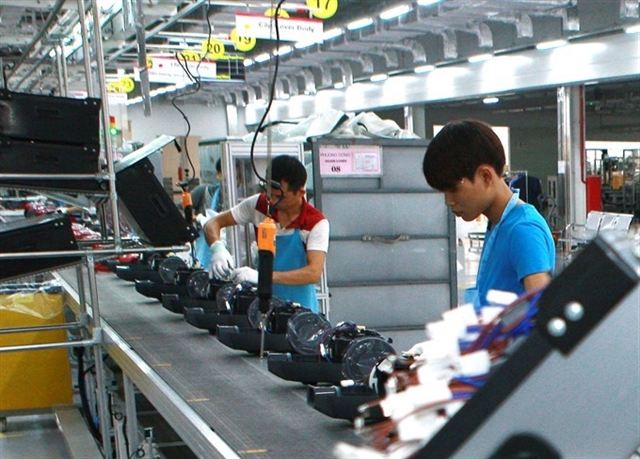 Economy
Economy

The Việt Nam Manufacturing Purchasing Managers' Index (PMI) dipped fractionally below the 50.0 no-change mark to 49.9 last month, signalling broadly unchanged business conditions during the month.

|
| Workers at a manufacturing chain inside an LG Electronics Việt Nam’s production plant in Hải Phòng. — VNA/VNS Photo Lâm Khánh |
HÀ NỘI — The Việt Nam Manufacturing Purchasing Managers' Index (PMI) dipped fractionally below the 50.0 no-change mark to 49.9 last month, signalling broadly unchanged business conditions during the month.
A survey by newly-released IHS Markit showed that the recovery in the Vietnamese manufacturing sector paused last month as a succession of storms and associated flooding hit the country.
This followed a reading of 51.8 in October and was the first sub-50 figure in three months. Output decreased slightly last month, thereby ending a two-month sequence of growth.
That said, anecdotal evidence suggested that the reduction could be temporary as a number of firms indicated that recent stormy weather and subsequent flooding had disrupted their production during the month. The COVID-19 pandemic was also a factor weighing on output.
New orders continued to rise, but only fractionally as business was impacted by the stormy weather conditions and flooding, as well as the pandemic. The latter had a particular effect on new export orders, which decreased solidly.
On the other hand, a number of respondents indicated that new orders had increased amid improving underlying demand.
With new order growth slowing, firms worked through outstanding business, leading to a tenth successive reduction in backlogs of work. The latest fall was solid, but softer than in October.
Falling workloads led firms to scale back their employment and purchasing activity last month. The modest reduction in staffing levels followed a slight rise in the previous month.
Purchasing activity decreased for the first time in three months.
The fall in input buying fed through to a reduction in stocks of purchases. In both cases, however, consumer goods producers bucked the wider trend by posting expansions.
Meanwhile, a reduction in output during the month resulted in a decrease in stocks of finished goods.
As well as hampering production, the stormy weather and COVID-19 pandemic combined to disrupt the delivery of purchased items to manufacturers. Suppliers' lead times lengthened for the twelfth successive month and to the greatest extent since August. Raw material shortages were also a factor behind delivery delays.
Shortages of raw materials contributed to rises in input costs during November, with difficulties importing items and higher prices in international markets also cited. Input prices increased sharply, and at the fastest pace since August 2018. The rate of output price inflation also quickened, but remained modest. The rise in charges was the greatest for two years.
Despite the setback in November, firms expect production to expand over the coming year. Confidence was centred on expectations that the COVID-19 pandemic would remain under control in Việt Nam and cause less disruption globally.
IIP increases slightly
The index of industrial production (IIP) last month is estimated to increase by 0.5 per cent from the previous month and by 9.2 per cent from the same period last year.
In which, the mining industry decreased by 6.2 per cent; processing and manufacturing increased 11.9 per cent; electricity production and distribution increased by 4 per cent; water supply and waste and wastewater management and treatment increased by 5.3 per cent.
The General Statistics Office's socio-economic situation report for November and 11 months of this year said that in the context of well-controlled COVID-19 pandemic in the country and the EU-Việt Nam Free Trade Agreement (EVFTA) created the driving force for sectors of the economy to recover and operate in the new normal states.
Generally, the IIP in the first eleven months of this year was estimated to increase by 3.1 per cent over the same period last year, lower than the 9.3 per cent increase of the same period last year.
Specifically, processing and manufacturing increased by 4.7 per cent, contributing 3.8 percentage points to the general growth; power generation and distribution rose 3.2 per cent, contributing 0.3 percentage points.
In addition, the water supply, waste and wastewater management and treatment sector increased four per cent, contributing 0.1 percentage points; the mining industry alone decreased by 7.1 per cent, down 1.1 percentage points in the overall growth. — VNS




